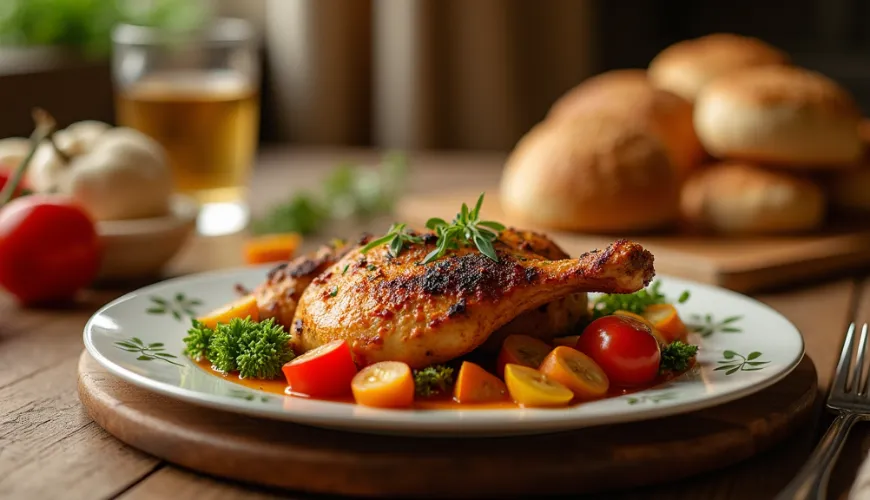
How to Cook Flamendr and Why You Will Love It

What is Flamendr and Why is it Returning to Czech Tables?
In Czech cuisine, there occasionally emerges a dish that appears new but actually has a long history and was merely forgotten for a while. One such dish is flamendr—a bold, hearty, and aromatic meal that is gaining popularity among lovers of traditional Czech cuisine as well as new generations of home cooks. Flamendr combines the best of Czech hospitality: simple ingredients, big flavor, and a hearty portion that satisfies.
Whether it's pork flamendr, a chicken variant, or the one known from pub menus, they all share a common trait—they don't hold back on flavor or spiciness. Some prepare it as a quick lunch on the pan, others as a hearty dinner with crispy bread or dumplings. But where did flamendr originate?
The Origin of Flamendr and Its Return to Kitchens
The name "flamendr" might be a mystery to some, but it actually has a rather colorful origin. Originally, it referred to a Flemish soldier, and later the term stabilized in Czech as slang for someone who wanders around pubs—perhaps a bit too often. The first mentions of this dish also come from the pub environment.
Pub flamendr began appearing mainly in the nineties as a flavorful, affordable, and filling snack that paired perfectly with beer. It was like a "beer goulash", but with more garlic, onion, pepper, and sometimes hot peppers. It was often served with bread or potatoes and was meant to—so they said—"kickstart the stomach."
While some traditional recipes have fallen into oblivion over time, flamendr has maintained its place thanks to its simplicity and strong flavor. In recent years, it has even appeared in various variations in households that favor home cooking without unnecessary pre-packaged foods.
How to Prepare Classic Pork Flamendr
When one says flamendr recipe, most Czechs think of the one with pork. It is the basic version of this dish, using common ingredients yet enchanting with its intense flavor.
The foundation is pork meat, most often shoulder or neck, cut into smaller pieces. These are quickly seared in lard or oil, a large amount of grated onion, crushed garlic, freshly ground pepper, salt, and sometimes a bit of paprika or chili are added. Some add a few drops of Worcestershire sauce or soy sauce to enhance the flavor. Everything is stewed in its own juices, possibly with a bit of broth.
The result is a sauce full of flavor, which pairs excellently with fresh bread, fries, or boiled potatoes. Pork flamendr is an ideal meal for cooler days—it warms you up and fills you up.
An interesting detail is that the recipe often doesn't have a precise form. Every pub, every household has its own version. This is the charm of flamendr—it's not a dish with a fixed recipe but rather an approach to cooking that favors intense flavor and simplicity.
Chicken Flamendr
For those who prefer lighter meat, there's chicken flamendr. The base is chicken breast or thigh fillets cut into strips. The process is very similar to the pork version—the meat is sautéed, onion, garlic, spices are added, and everything is stewed until tender and the flavors meld.
Chicken flamendr is less fatty and cooks faster, making it a popular option for work dinners or weekend lunches. It also pairs well with pasta or as a filling for tortillas.
Interestingly, the chicken variant often appeals to the younger generation, who seek quick meals with flavor but without complicated preparation and heavy ingredients. Yet even such flamendr retains its "pub" character—spicy, seasoned, and juicy.
Flamendr as a Return to Honest Cooking
At a time when there's often talk of returning to quality ingredients, home cooking, and limiting unnecessary additives, flamendr has a firm place. It contains no complex ingredients, no thickeners or artificial substances. Essentially, it gets by with what most people have at home—meat, onions, garlic, spices. And yet it's enough to create a dish with a distinct character.
One reason why flamendr is coming back into fashion is the growing emphasis on reducing food waste. If there's leftover meat from the previous day, it's easy to turn it into flamendr. Whether you use roasted pork, chicken, or even plant-based alternatives, the basic principle remains the same. It's a dish that allows for creativity and adaptation according to what's in the fridge.
Moreover, flamendr is a meal with a story. Anyone who has ever tasted it in a traditional pub might remember the atmosphere when it was served with draft beer and good company. It's a dish with a soul—and that's precisely why people are returning to it.
How to Adjust Flamendr to Your Taste
If you decide to cook flamendr at home, the possibilities are almost endless. The base remains—pieces of meat, onion, garlic, salt, pepper, and a bit of fat. But the rest is entirely up to your imagination.
- For spicy food lovers: add fresh chili pepper or a few drops of hot sauce.
- For vegetarians: replace the meat with sautéed mushrooms or tofu chunks and season similarly to classic flamendr.
- For kids: reduce the garlic and pepper, add a bit of sweet paprika, and serve with mashed potatoes.
- For a more festive version: add a splash of red wine or thyme for a deeper flavor.
One real-life example shows just how versatile this dish can be. Mrs. Alena from Vyškov says: "I cook flamendr when I don't know what to do with the meat from the fridge. I chop it, throw in some onion, garlic, a bit of pepper, and it's done in half an hour. It's best with homemade sourdough bread."
Her simple approach beautifully illustrates why flamendr remains so popular. It's not about the exact procedure, but about flavor and comfort.
Flamendr is once again becoming a symbol of honest home-cooked meals that can easily be adapted to personal needs. There's no need for complexity, just a few quality ingredients, a bit of time, and a desire to return to what worked for our grandmothers.

